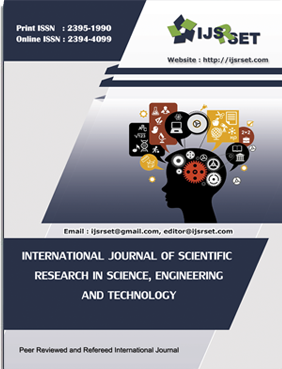Effect of Dimple Arrangement on The Thermal Performance of Dimpled Stepped Plate Heat Sink
DOI:
https://doi.org/10.32628/IJSRSET2293112Keywords:
Heat Sink, Base Temperature, Thermal Resistance, DimplesAbstract
Thermal management of electronic devices is the biggest problem in the electronic industry today. Heat sinks are one such devices that are used to cater this need and addition of dimples to these devices are proved to improve the thermal performance further. In the present study, computational analysis is carried out for comparing the stepped fin heat sinks with inline and staggered dimple arrangements having same number of dimples on each fin plate at velocities in the range of 0.5m/s to 4.5 m/s for 9 cases. The results of the computational study are validated by comparing it with the experimental results of previous literature. The outcomes reveal that there is negligible difference in thermal performance of the two heat sinks at lower velocities and this gap widens with increase in velocity. Out of the two-heat sink model, heat sink with inline arranged dimples proved to have better thermal performance at all the velocities considered.
References
- S N, S.K., S, S., H R, P. (2021). Heat transfer analysis of plate fin heat sink with dimples and protrusions: Investigation of new designs. International Journal of Heat and Technology, Vol. 39, No. 6, pp. 1861-1870. https://doi.org/10.18280/ijht.390621.
- Wen, MY., Yeh, CH. Natural convective performance of perforated HSs with circular pin fins. Heat Mass Transfer 51, 1383–1392 (2015). https://doi.org/10.1007/s00231-015-1504-8
- Umesh V. Awasarmol, Ashok T. Pise, An experimental investigation of natural convection heat transfer enhancement from perforated rectangular fins array at different inclinations, Experimental Thermal and Fluid Science, Volume 68, 2015, Pages 145-154, ISSN 0894-1777, https://doi.org/10.1016/j.expthermflusci.2015.04.008.
- Maiti A., & Prasad, B. (2017). Alternative HS to enhance thermo-hydraulic behaviour of an array of short pin fins. Proceedings of the World Congress on Mechanical, Chemical, and Material Engineering. doi: 10.11159/htff17.121
- Dafedar, Mohammad. (2013). Heat Transfer Augmentation In Different Geometries Of Dimpled Surface Under Natural Convection An Experimental Approach. International journal of research in engineering and technology. 02. 937-940. 10.15623/ijret.2013.0206004.
- Nopparat Katkhaw, Nat Vorayos, Tanongkiat Kiatsiriroat, Yottana Khunatorn, Damorn Bunturat, Atipoang Nuntaphan, Heat transfer behavior of flat plate having 45° ellipsoidal dimpled surfaces, Case Studies in Thermal Engineering, Volume 2, 2014, Pages 67-74, ISSN 2214-157X, https://doi.org/10.1016/j.csite.2013.12.002.
- Koonlaya Kanokjaruvijit, Ricardo F. Martinez-botas, Jet impingement on a dimpled surface with different crossflow schemes, International Journal of Heat and Mass Transfer, Volume 48, Issue 1, 2005, Pages 161-170, ISSN 0017-9310, https://doi.org/10.1016/j.ijheatmasstransfer.2004.08.005.
- SN, S. K. (2019). Recent developments in the design of heat sinks for heat transfer enhancement–A review. International Journal of Science, Technology, Engineering and Management-A VTU Publication, 1(4), 1-8. http://ijesm.vtu.ac.in/index.php/IJESM/article/view/464
Downloads
Published
Issue
Section
License
Copyright (c) IJSRSET

This work is licensed under a Creative Commons Attribution 4.0 International License.

